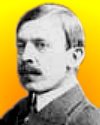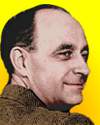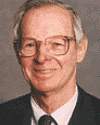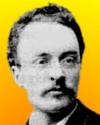 | TODAY IN SCIENCE HISTORY NEWSLETTER - 29 SEPTEMBER |
| Feature for Today |
 On 29 Sep 1859, Hermann Biggs was born, the American physician who was New York City's Public Health Officer and pioneered the use of bacteriological studies in the field of public health for the prevention and control of contagious diseases. On 29 Sep 1859, Hermann Biggs was born, the American physician who was New York City's Public Health Officer and pioneered the use of bacteriological studies in the field of public health for the prevention and control of contagious diseases. Today, vaccinating a baby is routine to prevent a number of diseases, including diphtheria, polio and tetanus, because these can cause death. It was not always so. First a suitable vaccine had to be developed and manufactured. Then the population had to become involved in an broad immunization effort. For each of these, there needed to be pioneers. One such pioneer was Hermann Biggs, who more than a century ago, took on the task of improving the collective public health in New York City. In The New Treatment of Diptheria, from The Century Magazine (Jan 1895), Biggs communicated to the general reader that “The new anti-toxine treatment of diphtheria promises to prove one of the most important developments of modern medicine.” In this article, you can read in his own words, how diphtheria antitoxin was being produced in the U.S. by the New York City Board of Health. In these early days of bacteriology, imagine how the magazine's readers may have reacted to such news, because they knew the deadly effects of diptheria as it occurred then. Then consider how the world has benefitted since then, and how routine such vaccinations have become. |
| Book of the Day | |
|
| Quotations for Today | |
 | Public health is purchasable. Within a few natural and important limitations any community can determine its own health. |
 | The human body is the only machine in which there are no spare parts. |
 | Whatever Nature has in store for mankind, unpleasant as it may be, men must accept, for ignorance is never better than knowledge. |
 | Young man, if I could remember the names of these particles, I would have been a botanist. |
| Quiz | |
| Before you look at today's web page, see if you can answer some of these questions about the events that happened on this day. Some of the names are very familiar. Others will likely stump you. Tickle your curiosity with these questions, then check your answers on today's web page. | |
| Births | |
 | Paul MacCready, born 29 Sep 1925, is an American aerodynamicist who headed a team that designed and built both the first man-powered aircraft and the first solar-powered aircraft capable of sustained flights. On 23 Aug 1977, the man-powered aircraft successfully demonstrated sustained, maneuverable manpowered flight. Can you name this man-powered aircraft? Can you name this man-powered aircraft? |
 | Enrico Fermi, physicist, born 29 Sep 1901 was one of the chief architects of the nuclear age. Working in America, he discovered neutron-induced radioactivity, and directed the first controlled chain reaction involving nuclear fission. What was Fermi's nationality at the outbreak of World War II? What was Fermi's nationality at the outbreak of World War II? |
| Deaths | |
 | Rudolf Diesel (1858-1913) was a German thermal engineer who was also a distinguished connoisseur of the arts, a linguist, and a social theorist. For what invention is he best known? For what invention is he best known? |
Friedrich Mohs (1773-1839) was a German mineralogist who devised a scale to compare mineral hardness, based on ten common or readily available minerals. Which minerals did Mohr select for the the least hard (1) and the most hard (10)? Which minerals did Mohr select for the the least hard (1) and the most hard (10)? | |
| Events | |
On 29 Sep 1891, a U.S. patent was issued to an inventor for a "Process of and Apparatus for Generating Electricity" and on 29 Sep 1914, a patent for a "Phonograph-Record" was granted to the same man. Who was this inventor? Who was this inventor? | |
On 29 Sep 1954, with ratifications complete, an organization was founded to provide first class facilities to coordinate fundamental research in particle physics. What is this organization, and where is it located? What is this organization, and where is it located? | |
| Answers |
| When you have your answers ready to all the questions above, you'll find all the information to check them, and more, on the September 29 web page of Today in Science History. Or, try this link first for just the brief answers. Fast answers for the previous newsletter for September 28: Seymour R. Cray • fluorine • he provided the first evidence of the expansion of the universe • his method of killing harmful bacteria in a liquid (such as milk) by holding it for a suitable time at a given temperature • amino acids • platinum-iridium. |
| Feedback |
 If you enjoy this newsletter, the website, or wish to offer encouragement or ideas, please send feedback by using your mail reader Reply button. If you enjoy this newsletter, the website, or wish to offer encouragement or ideas, please send feedback by using your mail reader Reply button. Your click on a StumbleUpon, Google+ or Facebook social button on the site webpages is also a welcome sign of appreciation. Thank you for using them. |
| Copyright |
| To find citations for quotations go to the corresponding webpage by clicking on the “quotes” balloon icon. Sources for the thumbnails appear on today's webpage with the corresponding item. � This newsletter is copyright 2013 by todayinsci.com. Please respect the Webmaster's wishes and do not put copies online of the Newsletter � or any Today in Science History webpage. (If you already have done so, please remove them. Thank you.) Offline use in education is encouraged such as a printout on a bulletin board, or projected for classroom viewing. Online, descriptive links to our pages are welcomed, as these will provide a reader with the most recent revisions, additions and/or corrections of a webpage. For any other copyright questions, please contact the Webmaster by using your mail reader Reply button. |
--
If you do not want to receive any more newsletters, Unsubscribe
To update your preferences and to unsubscribe visit this link


Δεν υπάρχουν σχόλια:
Δημοσίευση σχολίου